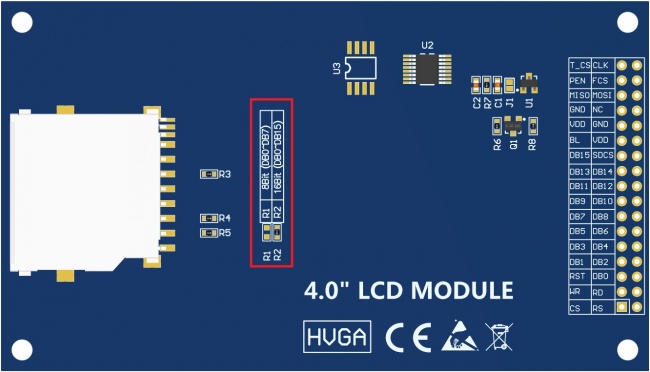4.3inch RGB Display
Contents
Product Picture
Product Description
- 4.3-inch color screen, support 24BIT RGB 16.7M color display, display rich colors
- Support 800x480, the display effect is very clear
- Support 24 bit RGB parallel bus transmission
- Compatible with RGB interface connection of punctual atomic development board and wildfire development board
- It supports the switching between capacitive touch screen and resistance touch screen, and the capacitive touch screen can support up to 5 touch points
- Support external adapter board, can be directly inserted into esp32 and STM32 development board
- Support PWM backlight brightness adjustment
- Provides a rich sample program for STM32 and C51 platforms
- Military-grade process standards, long-term stable work
- Provide underlying driver technical support
Product Parameters
| Name | Parameter |
| Display Color | RGB888 16.7M (compatible with rgb5665k) color |
| SKU | MRG4301(no touch), MRG4311(have touch) |
| Screen Size | 4.3(inch) |
| Type | TFT |
| Driver IC | None(It can be connected with ss1963 adapter board) |
| Resolution | 800*480 (Pixel) |
| Module Interface | 24Bit RGB parallel interface |
| Touch Screen Type | Capacitive or Resistive touch screen |
| Touch IC | FT5426(Capacitive touch), XPT2046(Resistive touch) |
| Active Area | 95.04x53.86(mm) |
| Module PCB Size | 105.41x86.41(mm) |
| Operating Temperature | -10℃~60℃ |
| Storage Temperature | -20℃~70℃ |
| Input Voltage | 5V |
| IO Voltage | 3.3V |
| Power Consumption | 50mA(The backlight is off), 165mA(The backlight is the brightest) |
| Rough Weight(Net weight) | 95(g) |
Interface Definition
The red box in the above figure is the 8-bit/16-bit data bus mode switch, which is described as follows:
- Solder R2 with 0Ω resistor or short circuit directly, and disconnect R1: Select 16-bit data bus mode (default),use DB0~DB15 data pin
- Solder R1 with 0Ω resistor or short circuit directly, and disconnect R2: Select 8-bit data bus mode use DB0~DB7 data pin
| Number | Pin Label | Description |
| 1 | CS | LCD reset control pin( low level enable) |
| 2 | RS | LCD register / data selection control pin(high level: register, low level: data) |
| 3 | WR | LCD write control pin |
| 4 | RD | LCD read control pin |
| 5 | RST | LCD reset control pin( low level reset) |
| 6 | DB0 | LCD data bus low 8-bit pin |
| 7 | DB1 | |
| 8 | DB2 | |
| 9 | DB3 | |
| 10 | DB4 | |
| 11 | DB5 | |
| 12 | DB6 | |
| 13 | DB7 | |
| 14 | DB8 | LCD data bus high 8-bit pin (not used in 8-bit data bus mode) |
| 15 | DB9 | |
| 16 | DB10 | |
| 17 | DB11 | |
| 18 | DB12 | |
| 19 | DB13 | |
| 20 | DB14 | |
| 21 | DB15 | |
| 22 | SDCS | SD card selection control pin (used when using the SD card expansion function, this test program is not used) |
| 23 | BL | LCD backlight control pin(High level light) |
| 24 | VDD | Module power positive pin (module has integrated voltage regulator IC, so the power supply can be connected to 5V or 3.3V) |
| 25 | VDD | |
| 26 | GND | Module power ground pin |
| 27 | GND | |
| 28 | NC | LCD backlight power positive pin (default shared onboard backlight power supply, this pin can not be connected) |
| 29 | MISO | Touch screen SPI bus data input pin |
| 30 | MOSI | Touch screen SPI bus data output pin |
| 31 | PEN | Touch screen interrupt detection pin(Low level when a touch occurs) |
| 32 | FCS | Flash chip select control pin (used when using the Flash extension function, this test program is not used) |
| 33 | T_CS | Touch screen IC chip select control pin(Low level enable) |
| 34 | CLK | Touch screen SPI bus clock control pin |
How to use on STM32 development board
This module is compatible with the ALIENTEK STM32 development board. The specific usage is as follows:
- Step 1: Download the test program
- Download the STM32 test program from the Program Download column
- For a description of the relevant test procedures, please refer to the test program documentation in the package
- Step 2: Connect the STM32 development board
- Find the TFTLCD Slot on the development board, connect the module pins and Slot(For example, the module CS pin corresponds to the slot CS pin),
- and then plug them directly into the Slot
- Step 3: Compile and download the program to the development board
- Compile and download the program you need to test to the STM32 development board( Don't know how to compile and download?)
- Step 4: Observe the running of the program
- After the program is finished, observe the running status of the program. If it can be displayed normally, the program runs successfully.
Program Download
Product Documentation
- 4.0inch 16bit Parallel-Port Module User Manual
- 4.0inch TFTLCD Specification
- 4.0inch 16bit Parallel-Port Module Size Picture(pdf Version)
- 4.0inch 16bit Parallel-Port Module Size Picture(jpg Version)
- 4.0inch 16bit Parallel-Port Module Schematic
- 4.0inch 16bit Parallel-Port Module LCD Schematic and PCB Package Library
- Driver IC ST7796S Data sheet
Reference Materials
- C51 Keil and stc-isp software use illustration
- STM32 keil software use illustration
- PCtoLCD2002 software use illustration
- Image2Lcd software use illustration
- Chinese and English display modulo settings
